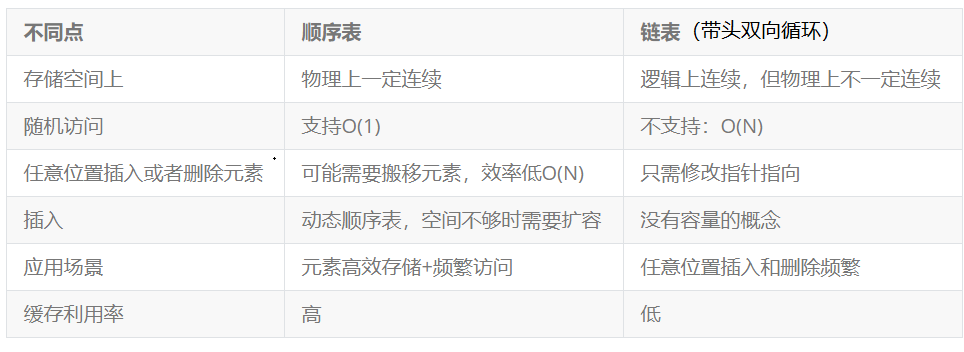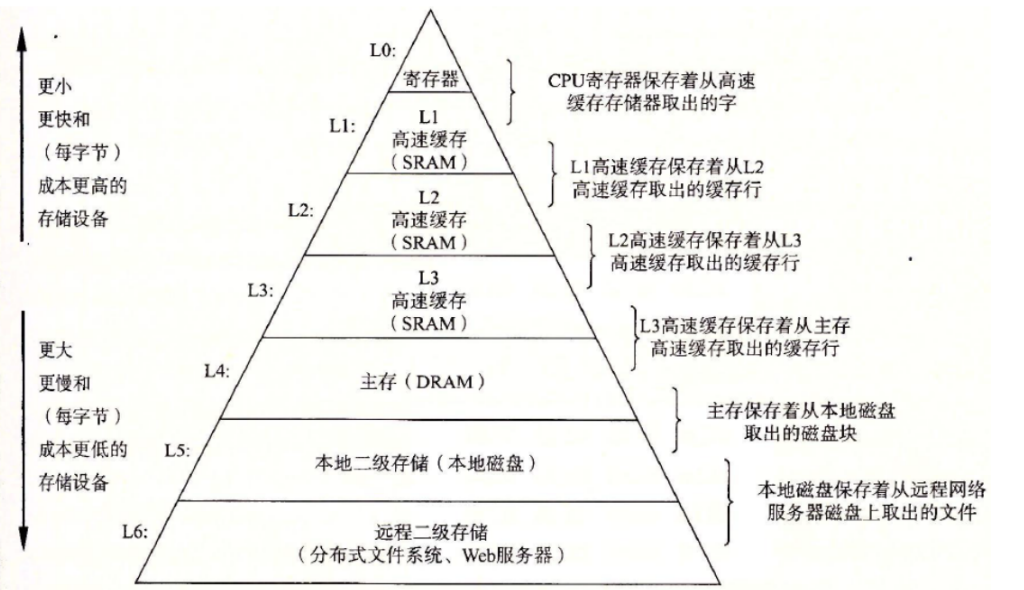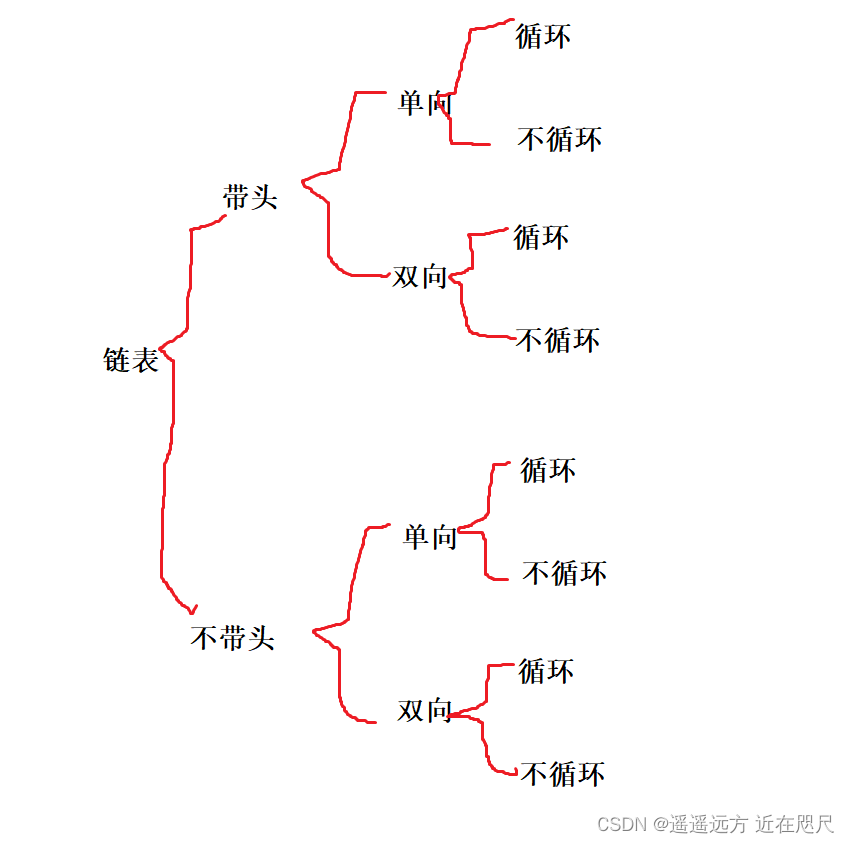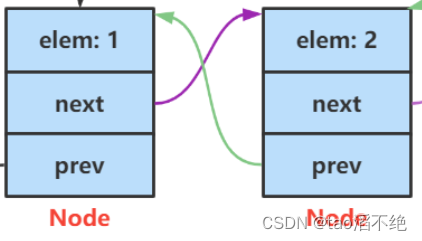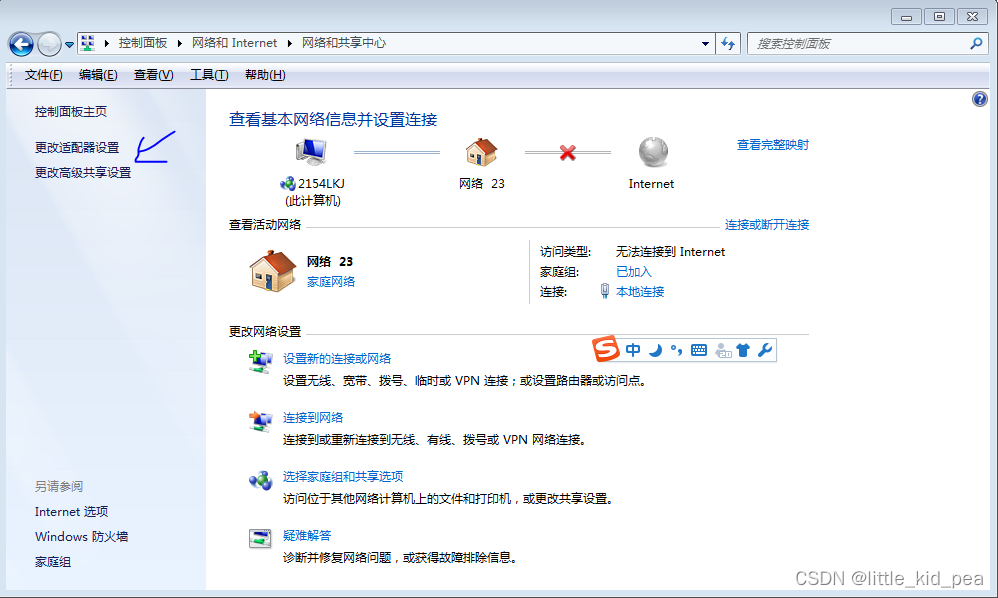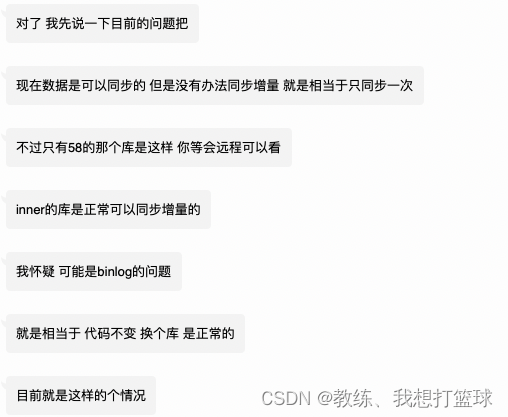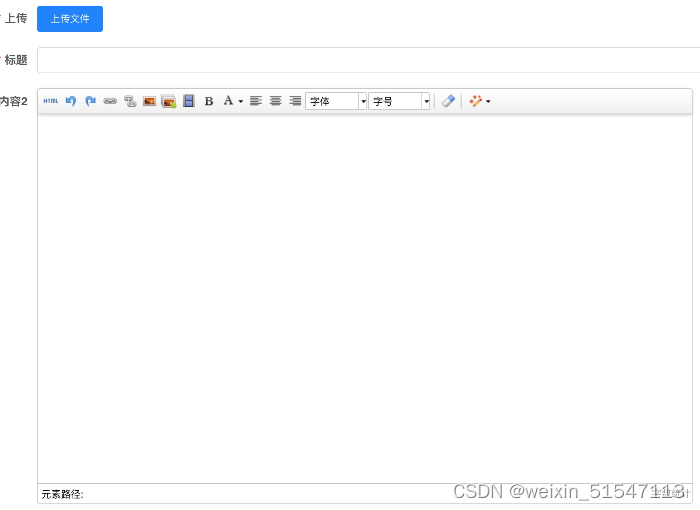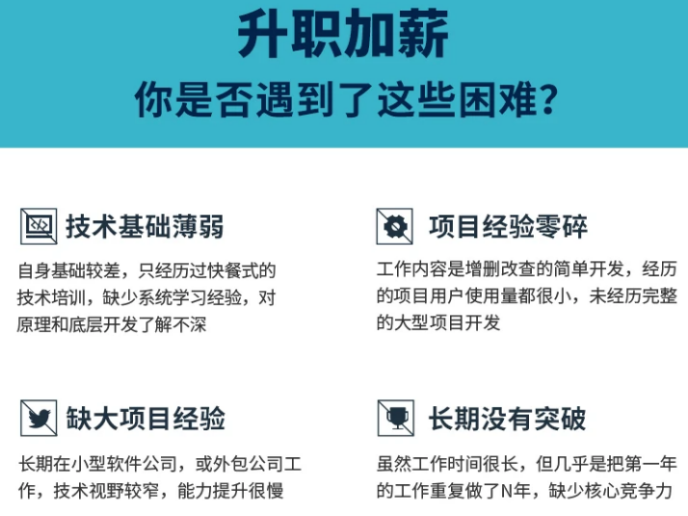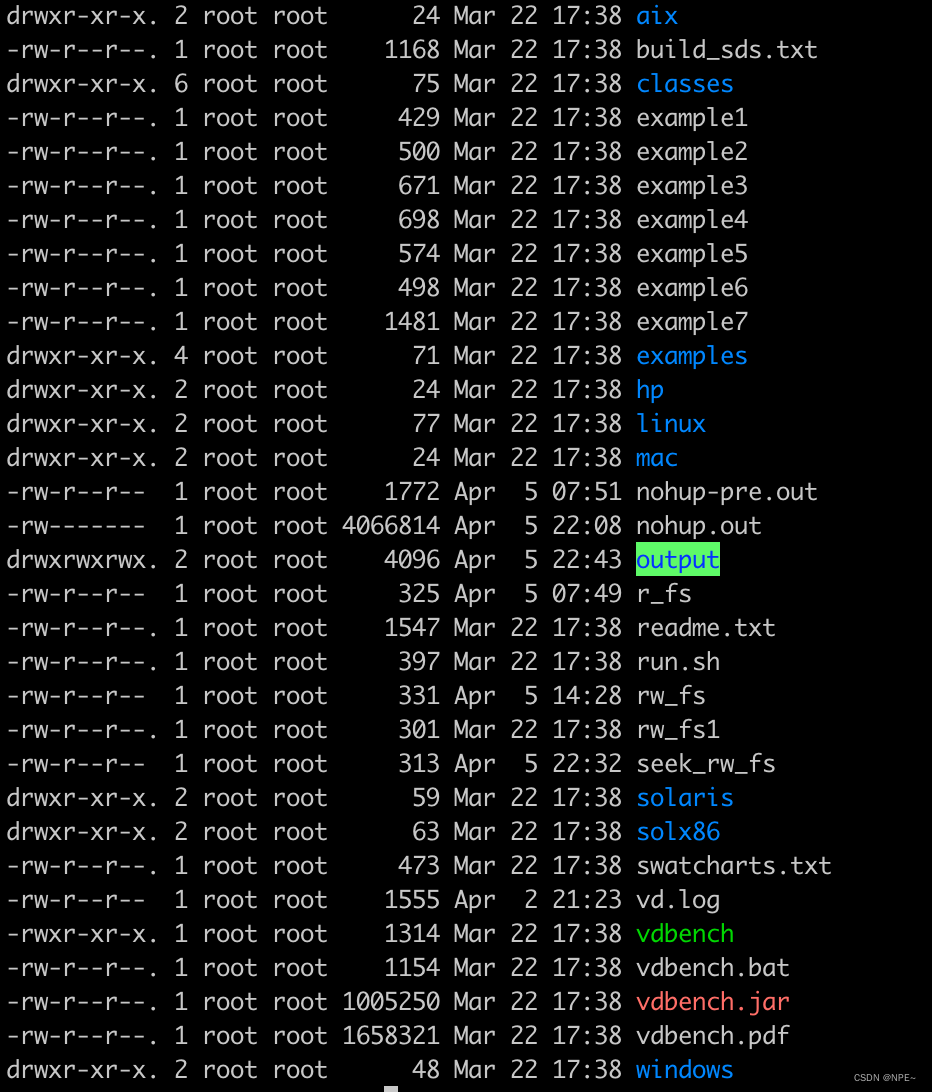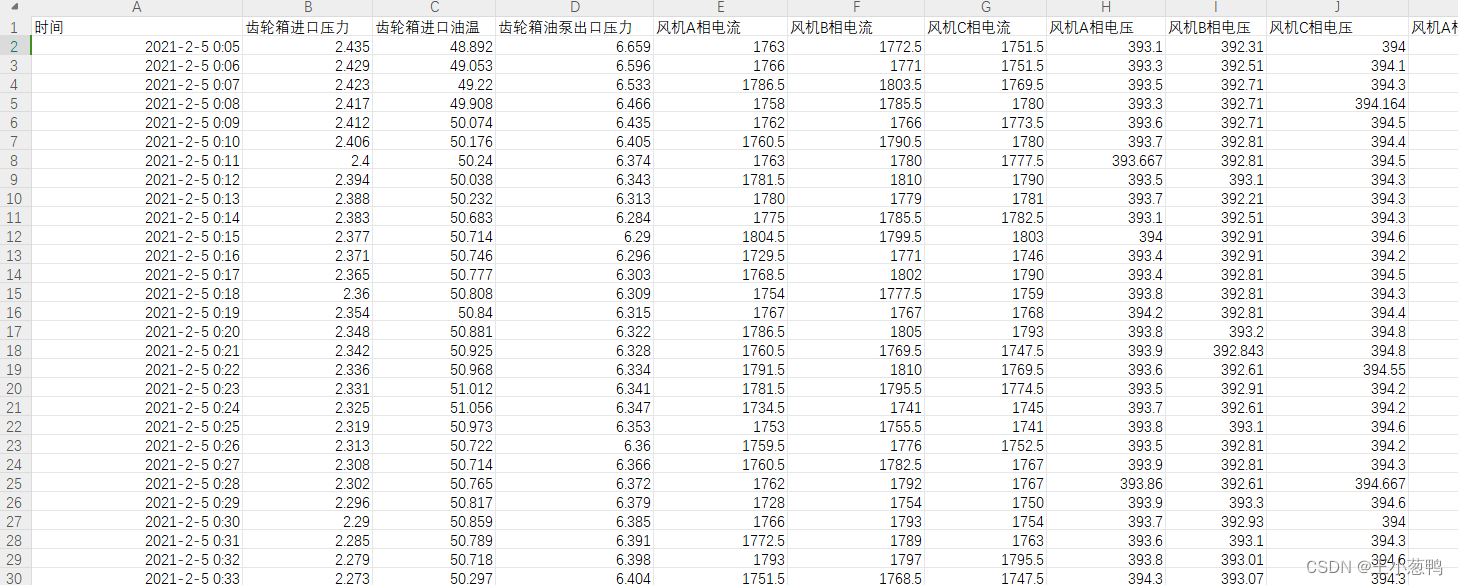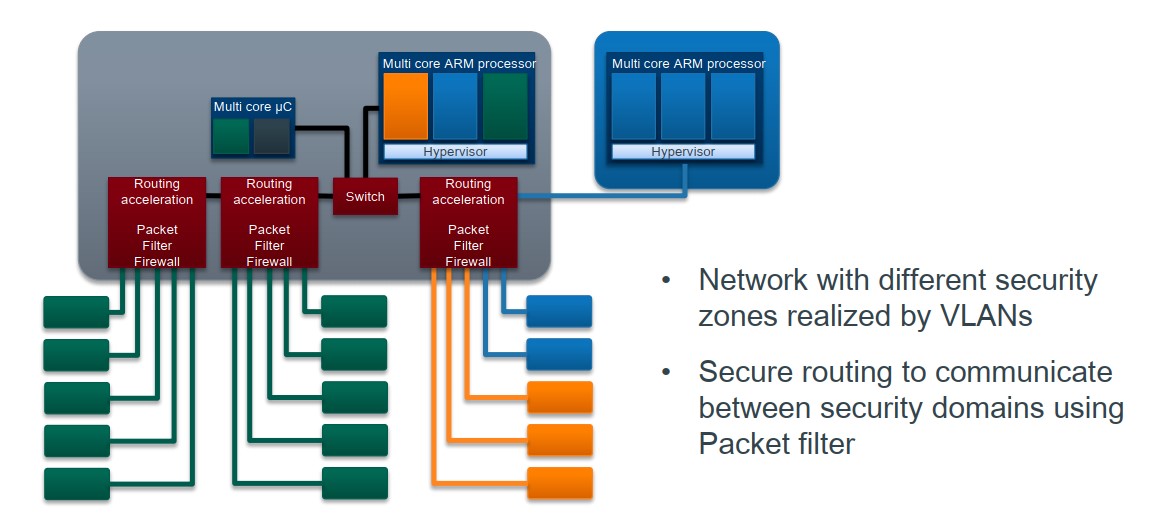1.双向链表的实现

1.1双向链表节点的结构声明
typedef int LTDataType;
typedef struct ListNode
{
struct ListNode* prev; // 指向该节点的前一个节点
struct ListNode* next; // 指向该节点的后一个节点
LTDataType data; // 该节点中存储的数据
}LTNode; // 将这个结构体重新命名为LTNode
1.2链表的初始化
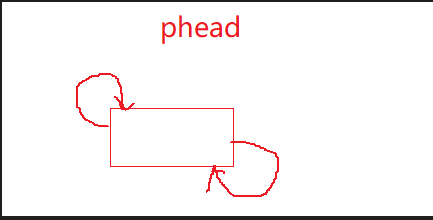
LTNode* ListInit()
{
// 创建一个节点,这个节点是哨兵位
LTNode* guard = (LTNode*)malloc(sizeof(LTNode));
if (guard == NULL)
{
perror("malloc fail");
exit(-1);
}
// 这是一个带头双向循环的链表
// 此时只有一个哨兵位,因此哨兵位的前一个节点和后一个节点都是哨兵位本身
guard->next = guard;
guard->prev = guard;
return guard;
}
1.3 链表的尾插
// 创建一个新节点
LTNode* BuyListNode(LTDataType x)
{
// 创建一个新节点
LTNode* node = (LTNode*)malloc(sizeof(LTNode));
if (node == NULL)
{
perror("malloc fail");
exit(-1);
}
// 初始化这个节点的指针,和数据
node->next = NULL;
node->prev = NULL;
node->data = x;
return node;
}

// 尾插
void ListPushBack(LTNode* phead, LTDataType x)
{
assert(phead);
// 尾插一个数据前,创建一个新节点,将这个数据存储到这个节点中
LTNode* newnode = BuyListNode(x);
// phead就是头节点,因为是双向循环链表,所以phead->prev就是双向循环链表的尾节点
LTNode* tail = phead->prev;
// 尾插一个新节点,就是将下面三个节点,按照顺序进行连接
// tail newnode phead
// 1.尾节点指向新节点
tail->next = newnode;
// 2.新节点的前指针,指向尾节点
newnode->prev = tail;
// 3.新节点的后指针,指向头节点
newnode->next = phead;
// 4.头节点的前指针,指向新节点,新节点成为这个双向循环链表的新的尾节点
phead->prev = newnode;
}
1.4链表的打印

void ListPrint(LTNode* phead)
{
assert(phead);
printf("phead<=>");
//不打印哨兵位的头
// phead就是哨兵位,不存储数据,因此不需要进行打印
LTNode* cur = phead->next;
// cur等于phead,说明已经循环了一周,所有的数据都已经被打印了
while (cur != phead)
{
printf("%d<=>", cur->data);
cur = cur->next;
}
printf("\n");
}
1.5链表的头插
- 方法一
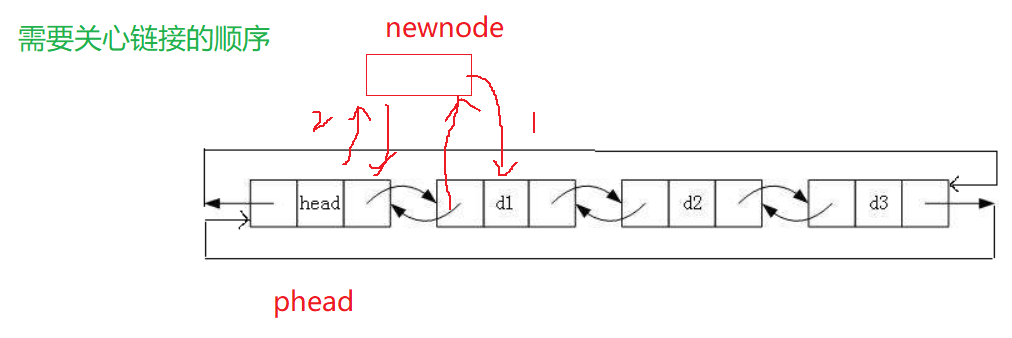
- 方法二
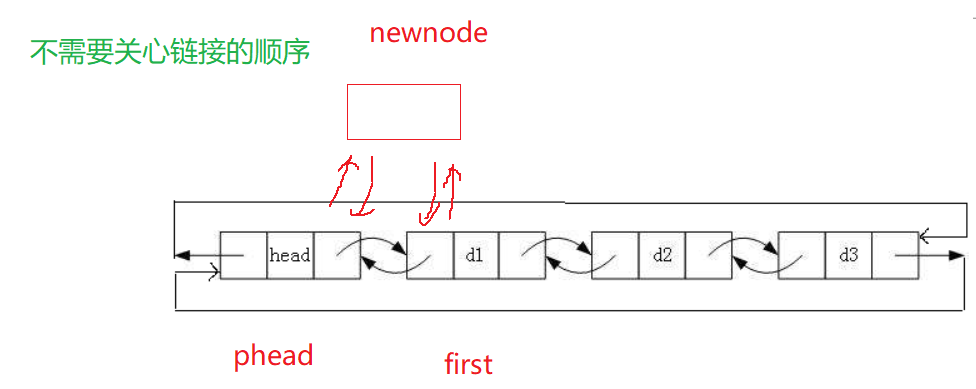
// 因为双向循环链表是有哨兵位的,头插的节点是插入到哨兵位之后的
// 也就是将 head newnode d1 这三个节点,按照顺序连接就可以
void ListPushFront(LTNode* phead, LTDataType x)
{
assert(phead);
// 方法一:
// 需要关心节点连接的循序(如果先执行第二步,那么phead指向的就是新节点,而不是d1节点)
// 创建一个要插入的新节点,存储的数据为x
LTNode* newnode = BuyListNode(x);
// 第一步
// phead->next就是d1节点
// 新节点的后指针指向d1节点
newnode->next = phead->next;
// phead->next->prev 就是d1节点的前指针;也就是d1节点的前指针指向新节点
phead->next->prev = newnode;
// 第二步
// 哨兵位的后指针指向新节点
phead->next = newnode;
// 新节点的前指针指向哨兵位
newnode->prev = phead;
// 方法二:
/*
// 不关心顺序(第一步和第二步哪个先执行都可以)
LTNode* newnode = BuyListNode(x);
// 1.先保存d1节点的地址
LTNode* first = phead->next;
// 第一步:
// 哨兵位的后指针指向新节点
phead->next = newnode;
// 新节点的前指针指向哨兵位
newnode->prev = phead;
// 第二步:
// 新节点的后指针指向d1节点
newnode->next = first;
// d1节点的前指针指向新节点
first->prev = newnode;
*/
// 方法三:
// 在phead->next位置前插入,也就是头插
// void ListInsert(LTNode* pos, LTDataType x) 这个函数就是在pos位置前插入一个节点
// ListInsert(phead->next, x);
}
1.6链表的尾删

// 用来判断是否为空链表,空链表无法头删
bool ListEmpty(LTNode* phead)
{
assert(phead);
// 方法一(比较麻烦)
/*
if (phead->next == phead)
return true;
else
return false;
*/
// 如果相等,那么就是空链表(因为这是一个双向循环链表)
return phead->next == phead;
}
void ListPopBack(LTNode* phead)
{
assert(phead);
assert(!ListEmpty(phead));
// 哨兵位的前指针指向的就是双向循环链表的尾节点
LTNode* tail = phead->prev;
// 尾节点的前指针指向的前节点将其命名为prev
LTNode* prev = tail->prev;
// 要进行尾删,也就是将 phead tail prev 三个节点中的tail删除,再将phead和prev连接
// 1.连接phead和prev
prev->next = phead;
phead->prev = prev;
// 释放要删除的节点空间,将其变为空指针,防止产生野指针
free(tail);
tail = NULL;
}
1.7链表的头删

// 对于双向循环链表,头删就是将 phead d1 d2中的d1节点删除,再将phead和d2节点连接
void ListPopFront(LTNode* phead)
{
assert(phead);
// 保证这个双向循环链表不是空链表
assert(!ListEmpty(phead));
// phead->next就是d1节点
LTNode* first = phead->next;
// phead->next->next就是d2节点
LTNode* second = first->next;
// 连接phead和d2节点
phead->next = second;
second->prev = phead;
// 释放d1节点
free(first);
first = NULL;
}
1.8链表节点的数量
size_t ListSize(LTNode* phead)
{
assert(phead);
size_t n = 0;
LTNode* cur = phead->next;
// 当cur != phead,说明链表循环一周结束
while (cur != phead)
{
++n;
cur = cur->next;
}
return n;
}
1.9链表的查找
LTNode* ListFind(LTNode* phead, LTDataType x)
{
assert(phead);
size_t n = 0;
// 哨兵位没有存储数据,不需要进行查找
LTNode* cur = phead->next;
while (cur != phead)
{
if (cur->data == x)
{
return cur;
}
// 迭代
cur = cur->next;
}
return NULL;
}
1.10在pos位置之前插入

// 在pos之前插入
// 也就是将prev newnode pos进行连接
void ListInsert(LTNode* pos, LTDataType x)
{
assert(pos);
// 将pos前指针指向的节点,命名为prev
LTNode* prev = pos->prev;
// 创建一个新节点
LTNode* newnode = BuyListNode(x);
// 连接3个节点 prev newnode pos;
prev->next = newnode;
newnode->prev = prev;
newnode->next = pos;
pos->prev = newnode;
}
头插
void ListPushFront(LTNode* phead, LTDataType x)
{
assert(phead);
//在phead->next之前插入,也就是头插
ListInsert(phead->next, x);
}
尾插

void ListPushBack(LTNode* phead, LTDataType x)
{
assert(phead);
//在phead之前插入,也就是尾插
ListInsert(phead, x);
}
1.11删除pos位置

void ListErase(LTNode* pos)
{
assert(pos);
// prev pos next
LTNode* prev = pos->prev;
LTNode* next = pos->next;
// 连接prev和next,释放pos节点
prev->next = next;
next->prev = prev;
free(pos);
//需要调用的人自行置空,因为pos是传值拷贝,在这里将pos置空,主函数中的pos并没有被改变
//pos = NULL;
}
尾删
void ListPopBack(LTNode* phead)
{
assert(phead);
assert(!ListEmpty(phead));
//删除phead->prev也就是尾删
ListErase(phead->prev);
}
头删
void ListPopFront(LTNode* phead)
{
assert(phead);
assert(!ListEmpty(phead));
// 删除phead->next也就是头删
ListErase(phead->next);
}
1.12销毁链表
void ListDestory(LTNode* phead)
{
assert(phead);
LTNode* cur = phead->next;
while (cur != phead)
{
LTNode* next = cur->next;
// 释放当前节点
free(cur);
// 迭代
cur = next;
}
// 释放哨兵位
free(phead);
// 可以传二级,内部置空头结点
// 建议:也可以考虑用一级指针,让调用ListDestory的人置空 (保持接口一致性)
// phead = NULL;
}
2.双向循环链表的完整实现
- List.h
#pragma once
#include <stdio.h>
#include <assert.h>
#include <stdlib.h>
#include <stdbool.h>
// 双链表的节点的结构体
typedef int LTDataType;
typedef struct ListNode
{
struct ListNode* next;
struct ListNode* prev;
LTDataType data;
}LTNode;
// 初始化一个双向循环链表
LTNode* ListInit();
// 销毁这个双向循环链表
void ListDestory(LTNode* phead);
// 打印链表
void ListPrint(LTNode* phead);
// 尾插
void ListPushBack(LTNode* phead, LTDataType x);
// 头插
void ListPushFront(LTNode* phead, LTDataType x);
// 尾删
void ListPopBack(LTNode* phead);
// 头删
void ListPopFront(LTNode* phead);
// 判断链表是否为空
bool ListEmpty(LTNode* phead);
// 链表的节点数量
size_t ListSize(LTNode* phead);
// 查找指定节点
LTNode* ListFind(LTNode* phead, LTDataType x);
// pos位置前插入节点
void ListInsert(LTNode* pos, LTDataType x);
// 删除pos位置的节点
void ListErase(LTNode* pos);
- List.c
#include "List.h"
// 初始化,并返回哨兵位的地址
LTNode* ListInit()
{
LTNode* guard = (LTNode*)malloc(sizeof(LTNode));
if (guard == NULL)
{
perror("malloc fail");
exit(-1);
}
guard->next = guard;
guard->prev = guard;
return guard;
}
// 创建一个新节点
LTNode* BuyListNode(LTDataType x)
{
LTNode* node = (LTNode*)malloc(sizeof(LTNode));
if (node == NULL)
{
perror("malloc fail");
exit(-1);
}
node->next = NULL;
node->prev = NULL;
node->data = x;
return node;
}
// 打印链表中的数据
void ListPrint(LTNode* phead)
{
assert(phead);
printf("phead<=>");
LTNode* cur = phead->next;
while (cur != phead)
{
printf("%d<=>", cur->data);
cur = cur->next;
}
printf("\n");
}
void ListPushBack(LTNode* phead, LTDataType x)
{
assert(phead);
ListInsert(phead, x);
}
void ListPushFront(LTNode* phead, LTDataType x)
{
assert(phead);
ListInsert(phead->next, x);
}
void ListPopBack(LTNode* phead)
{
assert(phead);
assert(!ListEmpty(phead));
ListErase(phead->prev);
}
void ListPopFront(LTNode* phead)
{
assert(phead);
assert(!ListEmpty(phead));
ListErase(phead->next);
}
bool ListEmpty(LTNode* phead)
{
assert(phead);
return phead->next == phead;
}
size_t ListSize(LTNode* phead)
{
assert(phead);
size_t n = 0;
LTNode* cur = phead->next;
while (cur != phead)
{
++n;
cur = cur->next;
}
return n;
}
LTNode* ListFind(LTNode* phead, LTDataType x)
{
assert(phead);
size_t n = 0;
LTNode* cur = phead->next;
while (cur != phead)
{
if (cur->data == x)
{
return cur;
}
cur = cur->next;
}
return NULL;
}
// 在pos之前插入
void ListInsert(LTNode* pos, LTDataType x)
{
assert(pos);
LTNode* prev = pos->prev;
LTNode* newnode = BuyListNode(x);
// prev newnode pos;
prev->next = newnode;
newnode->prev = prev;
newnode->next = pos;
pos->prev = newnode;
}
// 删除pos位置
void ListErase(LTNode* pos)
{
assert(pos);
LTNode* prev = pos->prev;
LTNode* next = pos->next;
prev->next = next;
next->prev = prev;
free(pos);
//pos = NULL;
}
// 可以传二级,内部置空头结点
// 建议:也可以考虑用一级指针,让调用ListDestory的人置空 (保持接口一致性)
void ListDestory(LTNode* phead)
{
assert(phead);
LTNode* cur = phead->next;
while (cur != phead)
{
LTNode* next = cur->next;
free(cur);
cur = next;
}
free(phead);
}
- main.c
#define _CRT_SECURE_NO_WARNINGS
#include "List.h"
void TestList1()
{
// 初始化链表
LTNode* plist = ListInit();
ListPushBack(plist, 1);
ListPushBack(plist, 2);
ListPushBack(plist, 3);
ListPushBack(plist, 4);
ListPrint(plist);
ListPushFront(plist, 10);
ListPushFront(plist, 20);
ListPushFront(plist, 30);
ListPushFront(plist, 40);
ListPrint(plist);
ListPopBack(plist);
ListPopBack(plist);
ListPopBack(plist);
ListPopBack(plist);
ListPrint(plist);
ListPopBack(plist);
ListPopBack(plist);
ListPopBack(plist);
ListPopBack(plist);
ListPrint(plist);
// 防止内存泄漏
ListDestory(plist);
plist = NULL;
}
void TestList2()
{
LTNode* plist = ListInit();
ListPushBack(plist, 1);
ListPushBack(plist, 2);
ListPushBack(plist, 3);
ListPushBack(plist, 4);
ListPrint(plist);
ListPopFront(plist);
ListPopFront(plist);
ListPrint(plist);
ListPopFront(plist);
ListPopFront(plist);
ListPrint(plist);
ListDestory(plist);
plist = NULL;
}
void TestList3()
{
LTNode* plist = ListInit();
ListPushBack(plist, 1);
ListPushBack(plist, 2);
ListPushBack(plist, 3);
ListPushBack(plist, 4);
ListPrint(plist);
// ...
}
int main()
{
TestList2();
return 0;
}
3.顺序表和链表的区别
